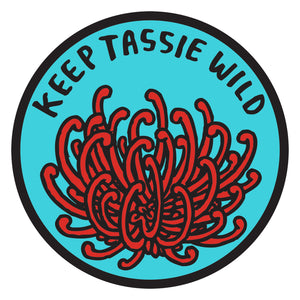Never mind the metaphor, I’m taking this literally. Lately, I’ve had this weird craving to see some butterflies…
Butterflies are everywhere when you’re a kid. In picture books, on sticker sheets, on the cover of colourful diaries and adorning dresses. The changing of a caterpillar to a butterfly is one of the first bits of true magic we learn about. They seem ubiquitous with childhood and flutter happily through my memories, weaving in and out of that hazy, joyful montage. The problem is, now with kids of my own, they seem to be everywhere but outside.
A quick Google search gives me the good news. They’re not all dead; they just mostly appear in the warmer months. So, my craving has come a little early, like wishing for daffodils in Autumn. Chill out, Josh.
The bad news is that insect numbers are falling all over the world and in Tassie we’ve got one of the most endangered butterflies in Australia!
While it might sound like a one-night stand from your auntie’s wild night on the northwest coast back in the ‘80s, the Marrawah skipper (Oreisplanus munionga subsp. larana) is in fact a butterfly in deep trouble: an article from a few years ago in the Guardian put its chances of extinction by 2040 at 33%! Not cool.
Part of the reason they’re in trouble is because of land clearing. Butterflies can be super fussy when it comes to habitat, and often only lay eggs on one species of plant.
One of these is another endangered Tassie butterfly: the ptunarra brown butterfly (Oreixenica ptunarra). This temperamental little dude only flies for three weeks in mid-March between 10am and 4pm, only if the temperature is 18 °C or above and there’s no wind, rain or extensive cloud cover!
As if that wasn’t specific enough for you, it lays its eggs on the native silver tussock grass in poa grasslands, one of the most endangered vegetation types in the state. Interestingly, the flowers of an abundant common Tasmanian weed, the dandelion, are noted as an important source of nectar in autumn when there aren’t many other options.
So, I wonder, what can we do to help? Well, it turns out it ain’t just about planting flowers…
While planting flowering plants is a great way in general to attract pollinators (think bees, bats, birds, beetles and butterflies), we need to take the whole lifecycle into account. Just like the ptunarra brown butterfly, lots of butterflies lay their eggs in native sedges and grasses. This means that planting clumps of these plants in your garden will create an excellent area for their little babies to grow. And making sure you plant a variety of species is even better, as this increases the options for our little flappy friends.
“But I want to plant flowers!” I hear you scream. Ok, ok… After chatting to some wonderful scientists at the Tasmanian Land Conservancy (TLC), I’ve learnt that planting members of the daisy family (scientific name: Asteraceae) will add beautiful pops of colour to your garden and are great for attracting bugs of all kinds. Let these go to seed and slowly but surely your garden will be filled with an abundance of plants that butterflies find irresistible!
And anything we should avoid? YES! Avoid pesticides at all costs! Simple as that.
Around where we live a threatened butterfly called Chaostola Skipper (Antipodia chaostola subsp. Leucophaea) lays its eggs on thatch saw-sedge and Gahnia microstachya that are scattered throughout dry forests and the caterpillars of an absolute beauty, the Macleay’s Swallowtail (Graphium macleayanus), feed on two of our favourite Tassie plants: sassafras and mountain pepper!
So, this spring I’m gonna plant me some daisies and sedges up the back, some sassafras around the side, and pray to the insect gods that some little Swallowtails and Skippers come skippin’ my way this spring.
...
This article could not have been written without the help of Cath Dickson, Hayley Kingsley & Phil Wise from the Tasmanian Land Conservancy.
Flirting with the idea of creating a beautiful, native, animal attracting garden? Why not make it official by registering with TLC’s ‘Garden for Wildlife’ program.
Enjoyed this article? Why not check out our articles on Tasmania's Central Plateau or Cushion Plants.






